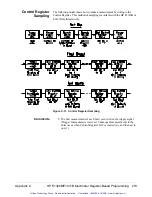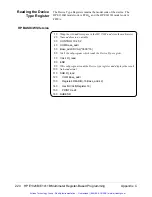
Converting Four-Byte
and Two-Byte Readings
Four-byte readings and two-byte readings are converted to voltages and
resistances as follows.
Four-Byte Readings
1. The four-byte reading should be arranged into a single 32-bit
variable. The upper two bytes from the first Data Register read must
be the most significant word, the lower two bytes from the second
Data Register read must be the least significant word.
2. The 32-bit quantity is then shifted 8 bits to the left to remove the
eight reading header bits (effoprrr). Note that this header is used to
determine overrange conditions, and contains the function and range
opcodes.
3. The reading is calculated as:
converted_reading = (range * shifted_reading)/0x7FFFFF00
where
range
is the multimeter’s voltage or resistance range and
0x7FFFFF00
is the full scale reading for the given range in hexadecimal.
The “Programming Examples” section contains examples for
converting four-byte readings.
Two-Byte Readings
1. After the two-byte reading is retrieved from the Data Register, the
reading is shifted one bit to the right to remove the error bit. Note
that this bit is used to determine overrange conditions.
2. The reading is calculated as:
converted_reading = (range * shifted_reading)/0x3FFF
where
range
is the multimeter’s voltage or resistance range
and
0x3FFF
is the full scale reading for the given range in hexadecimal.
The “Programming Examples” section contains examples for
converting two-byte readings.
Appendix C
HP E1326B/E1411B Multimeter Register-Based Programming 209
Artisan Technology Group - Quality Instrumentation ... Guaranteed | (888) 88-SOURCE | www.artisantg.com
















































